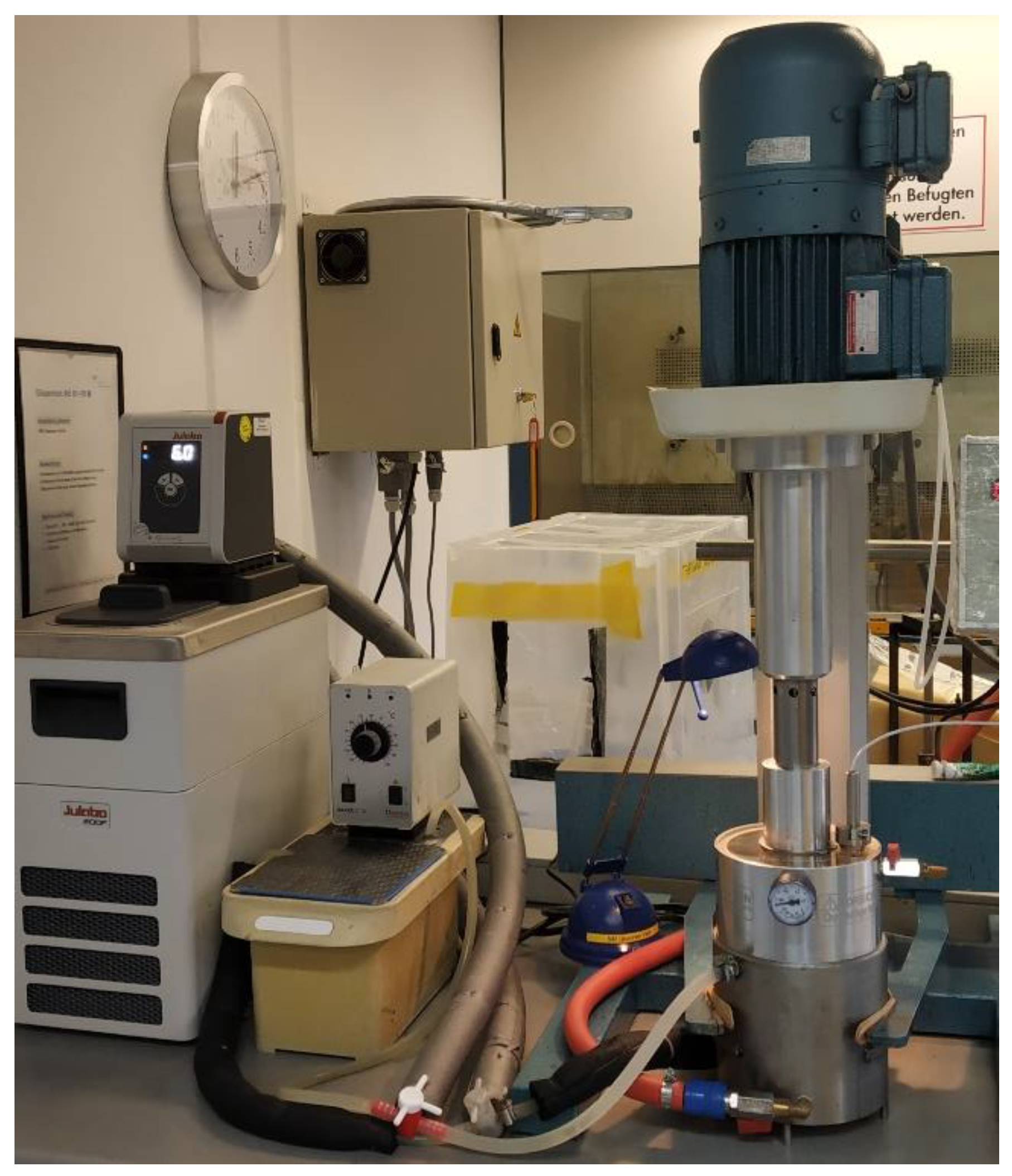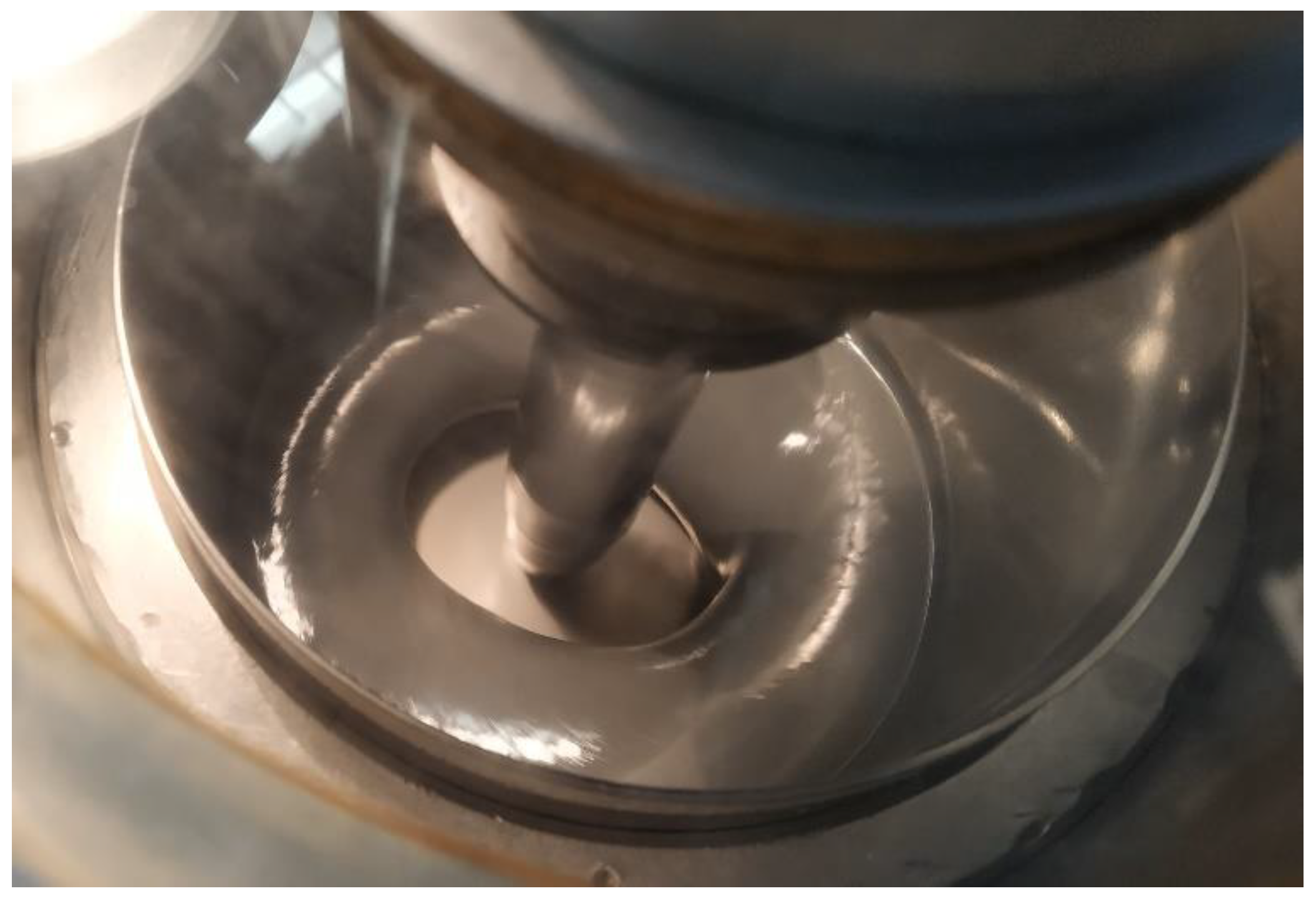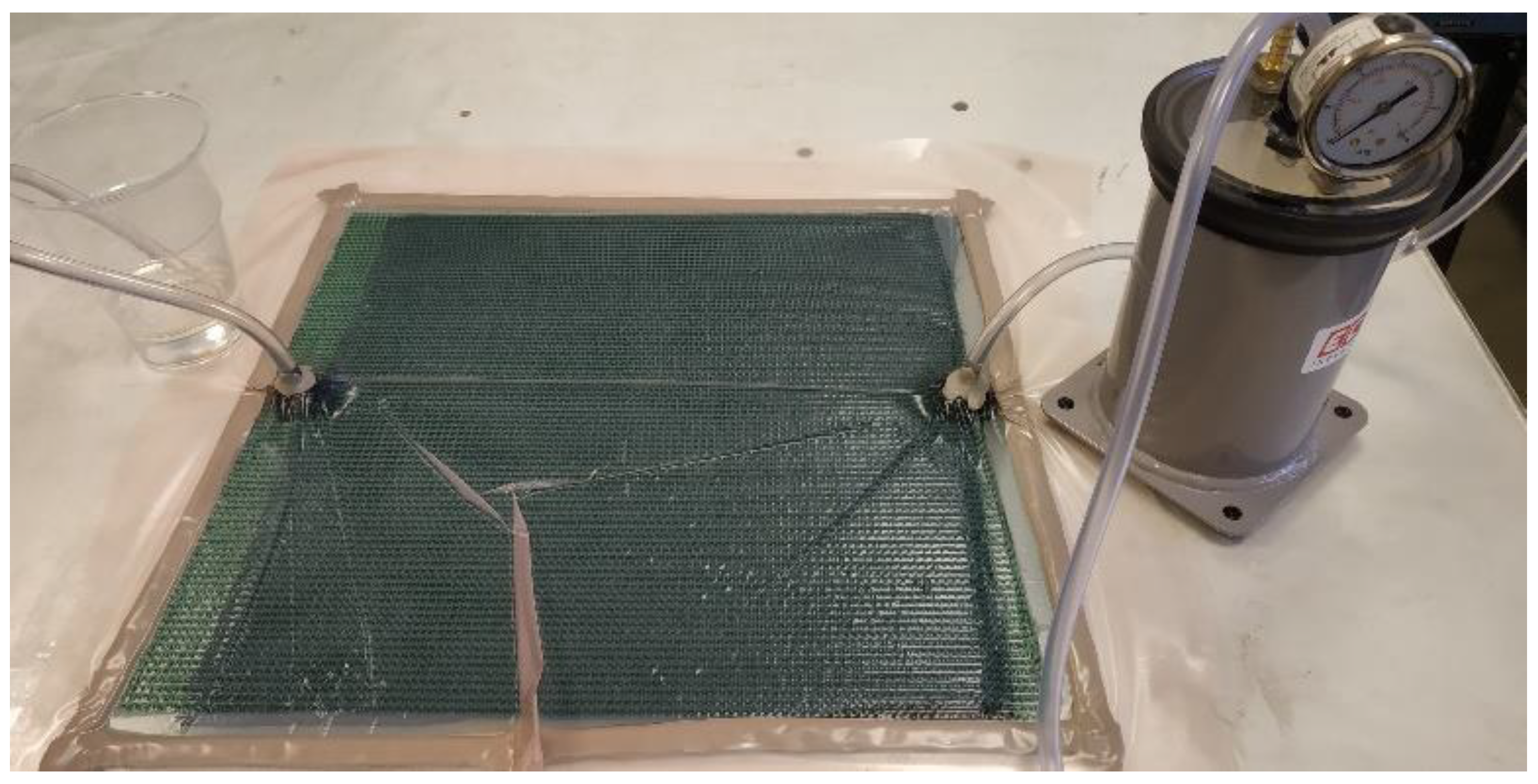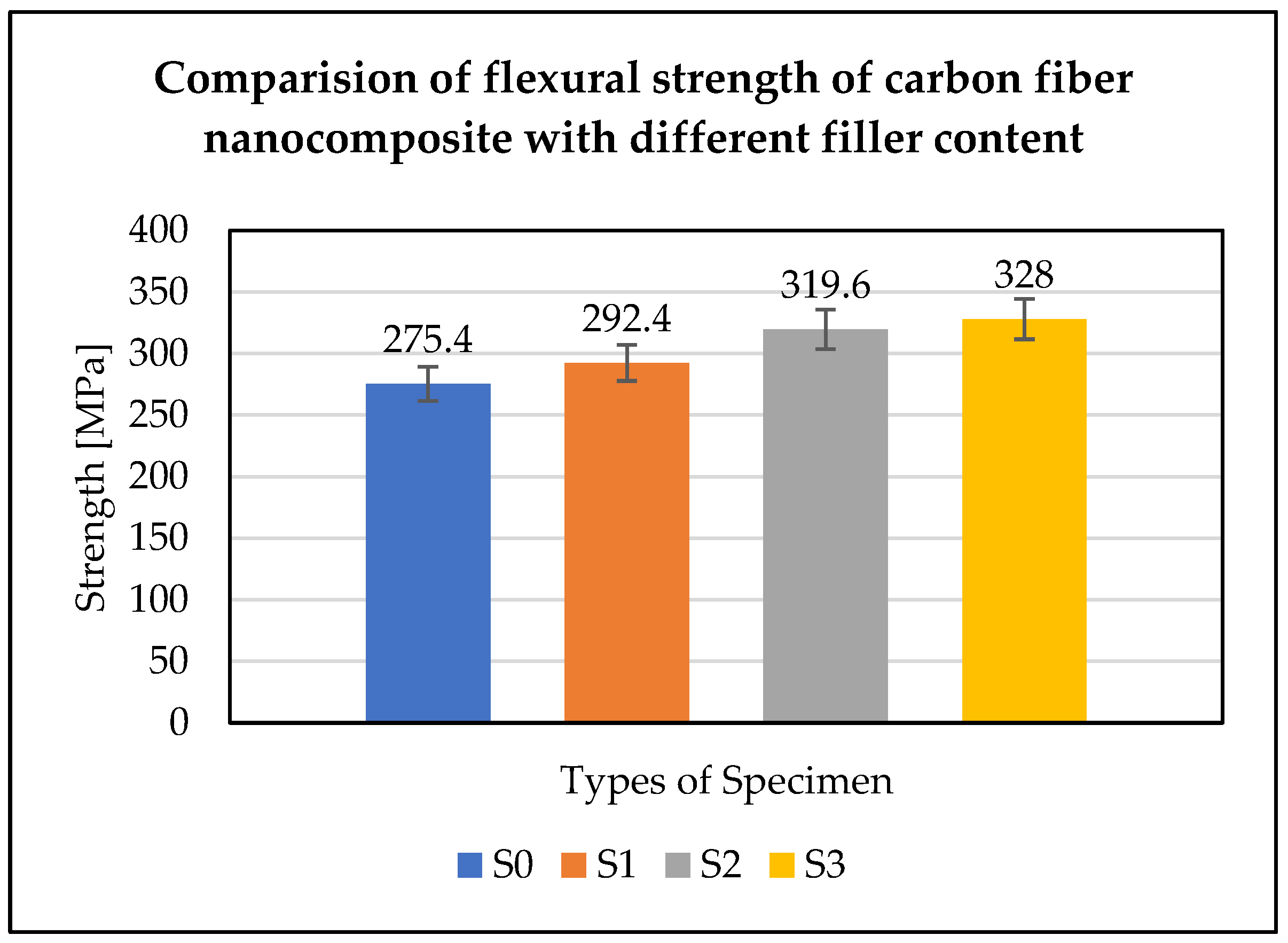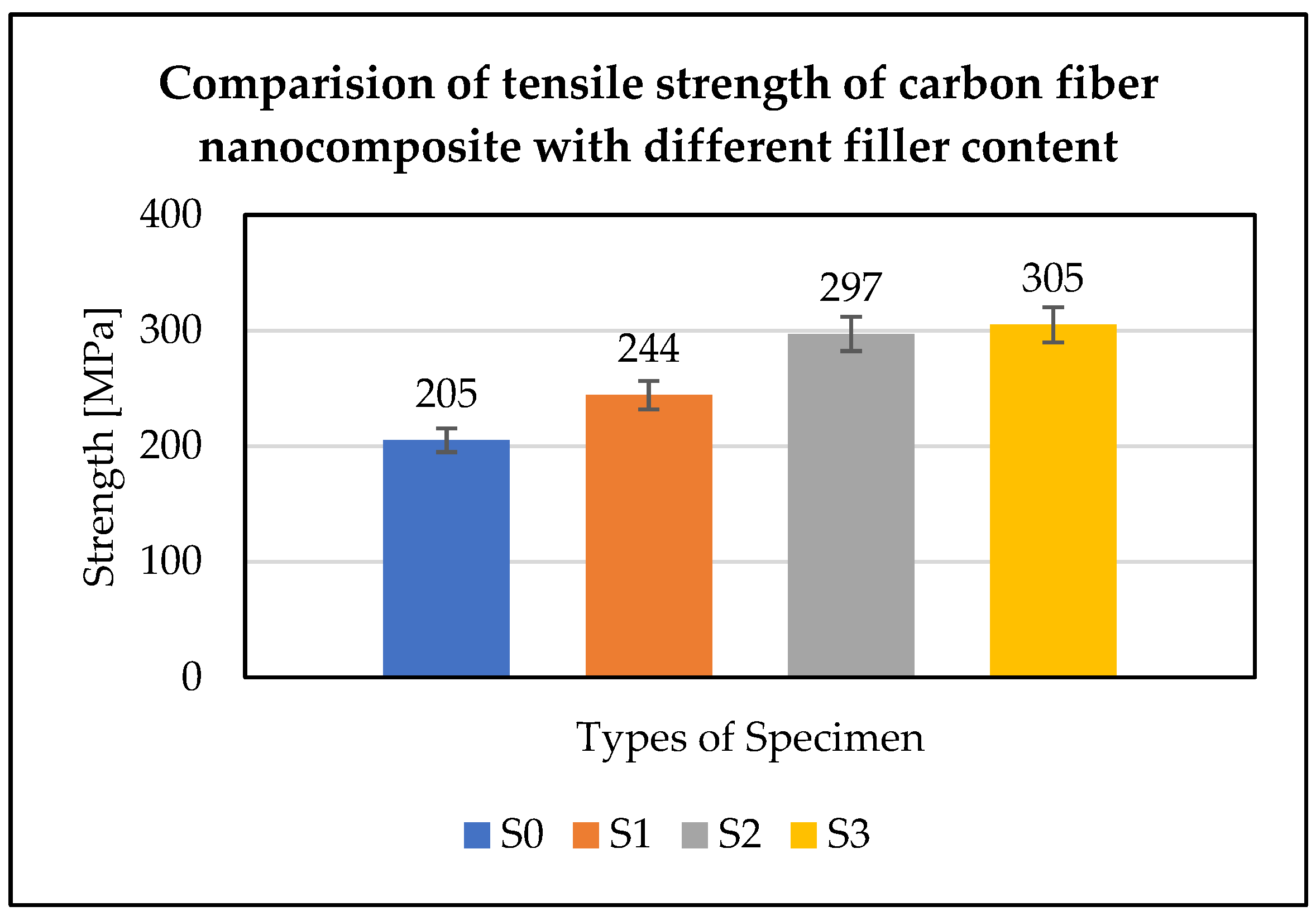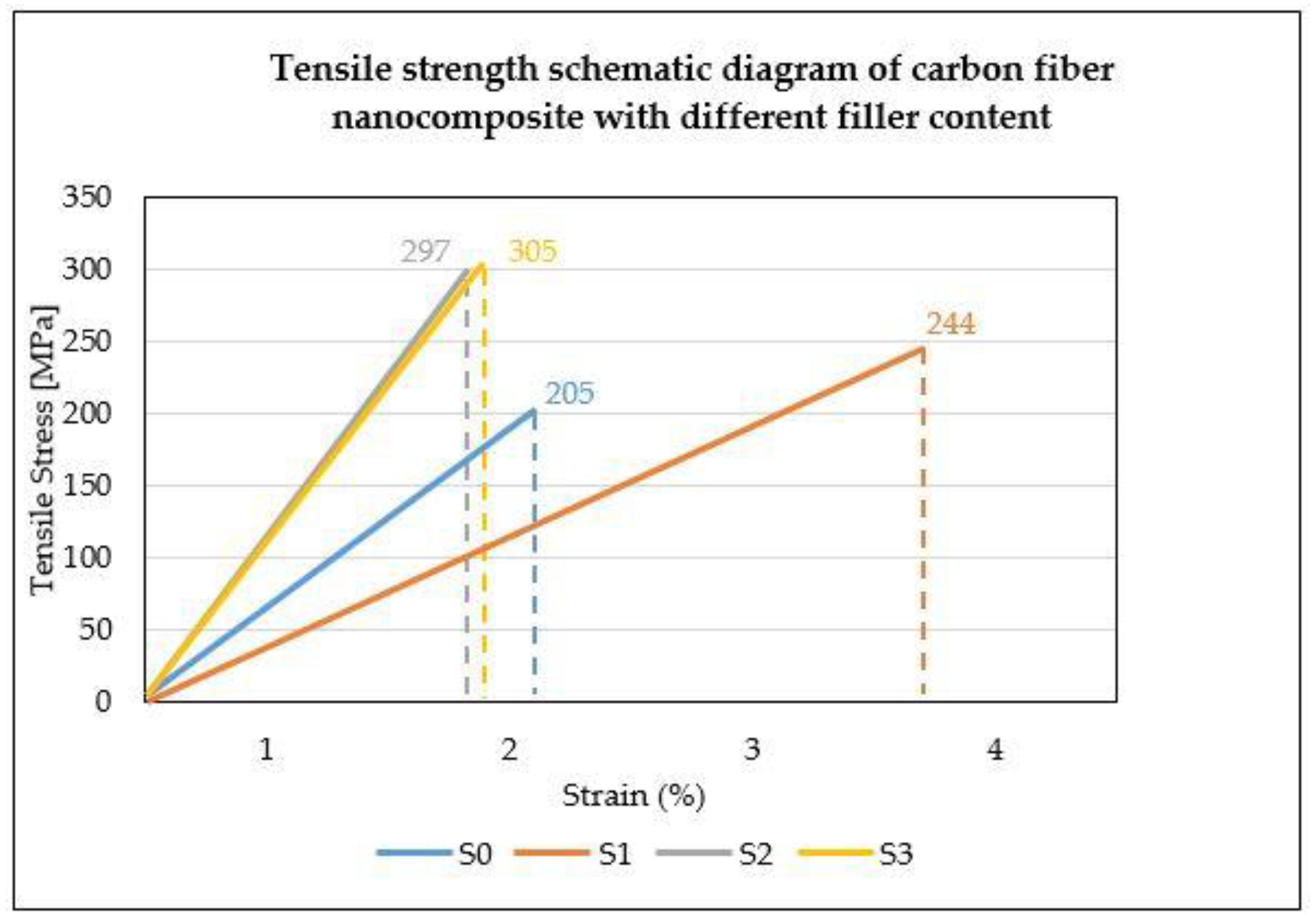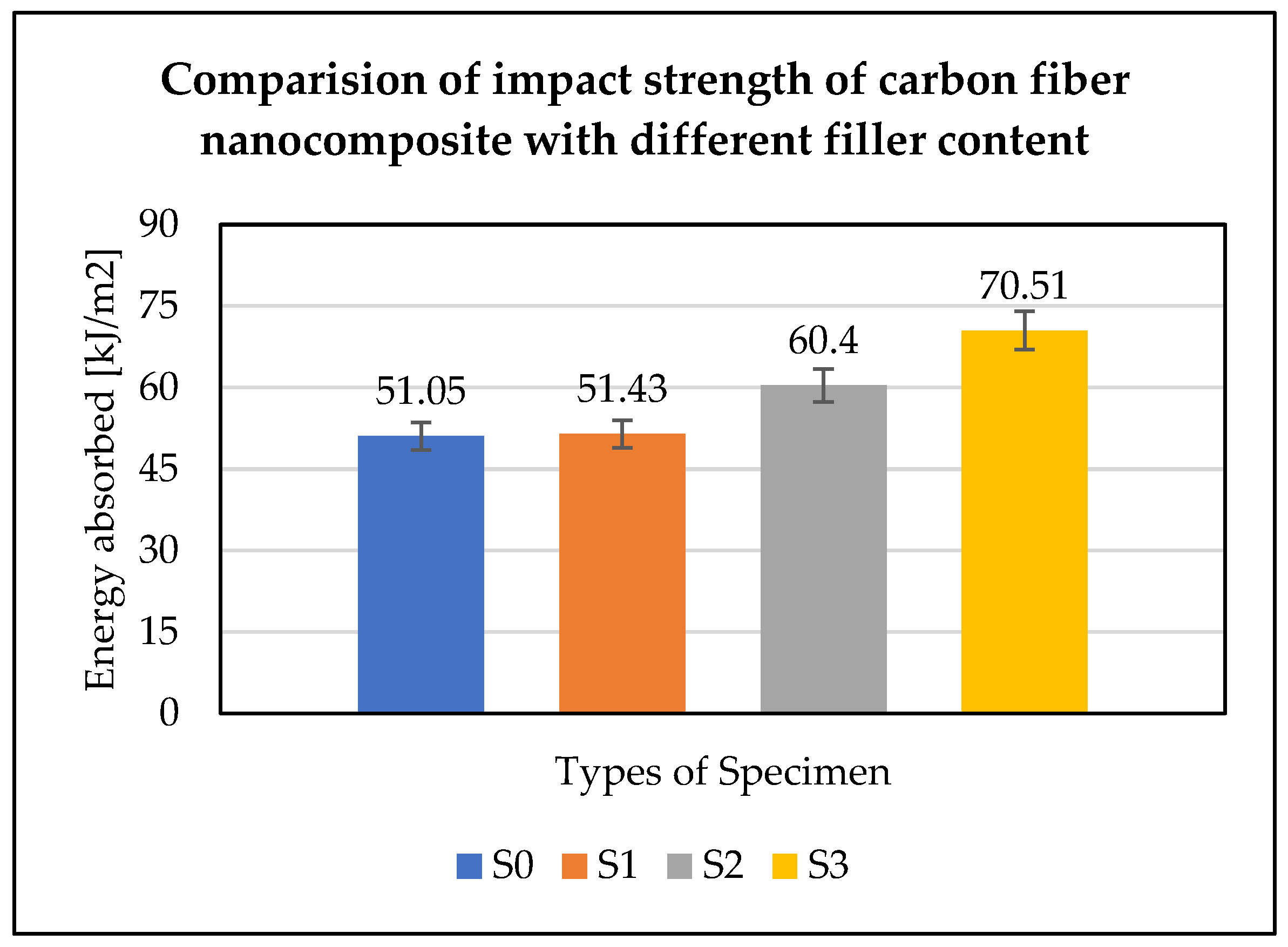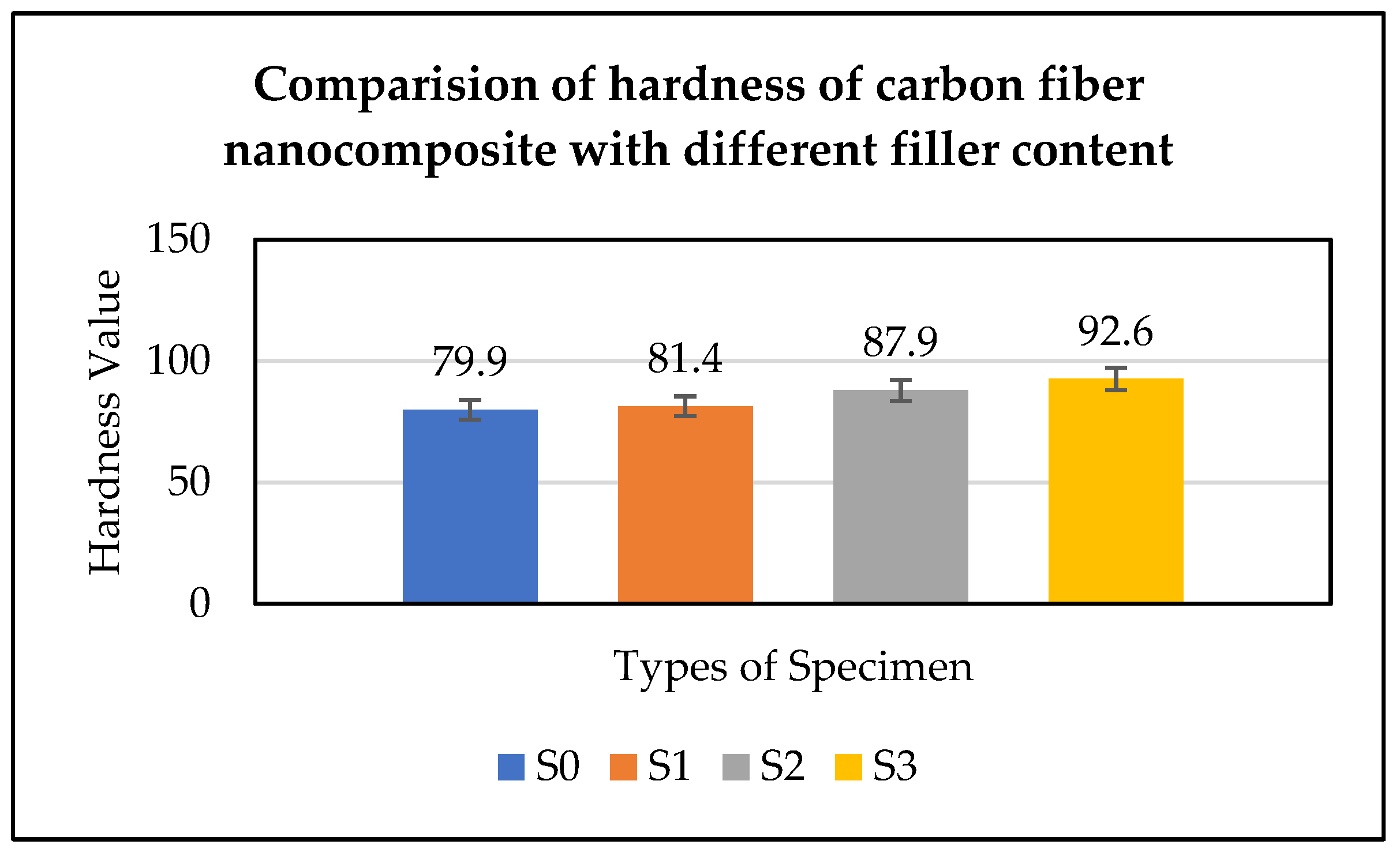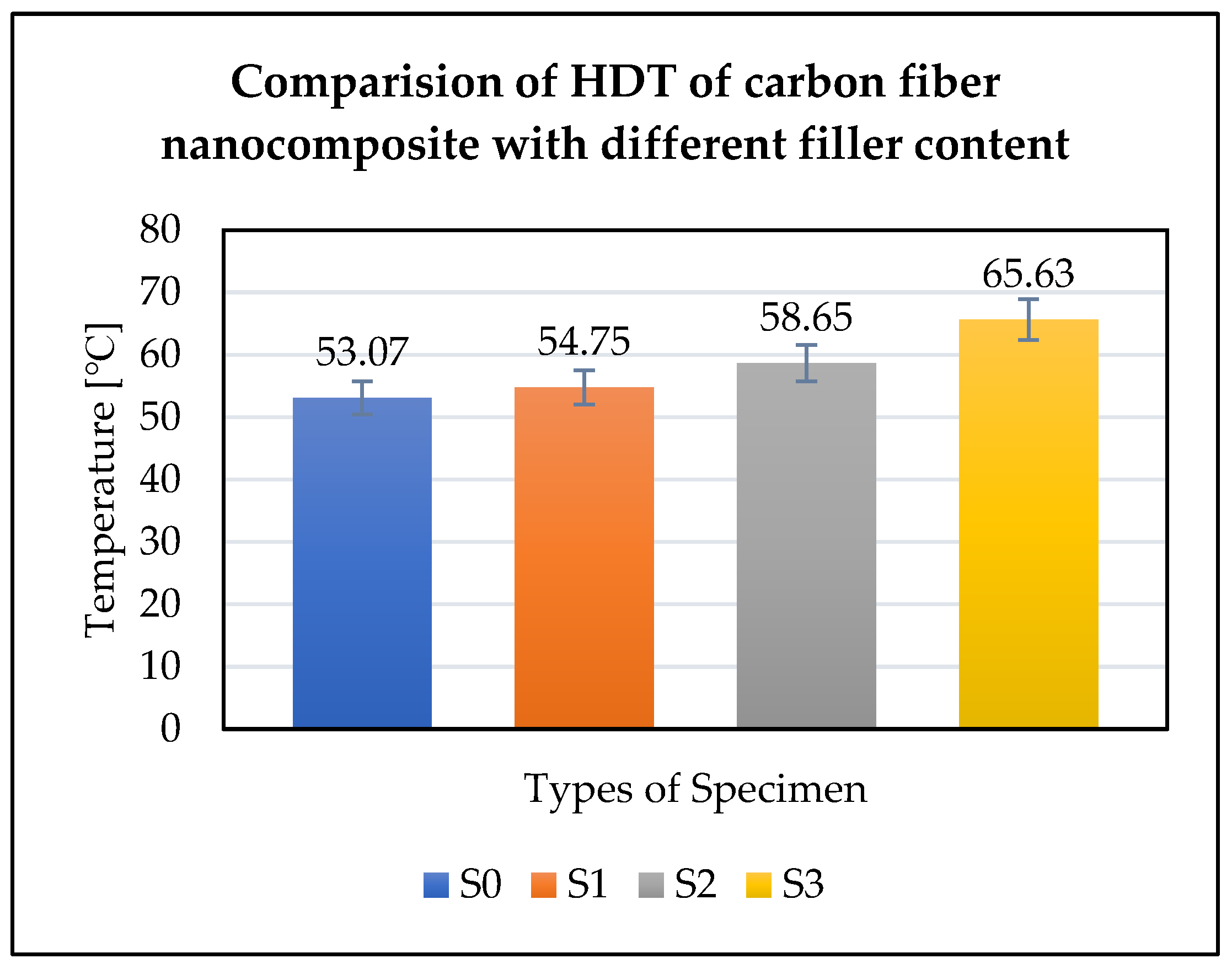1. Introduction
A composite material is composed of at least two materials, which combine to give properties superior to those of the individual constituents. Composite materials and specifically carbon fiber reinforced polymers (CFRPs) play a significant role as structural aerospace components due to their exceptional strength and stiffness-to-density/weight ratio [
1]. Composites give us the ability to manufacture parts with complicated geometry using fewer components enabling manufacturers to save cost [
2].
A nanomaterial is a material with nanoscale particles or constituents, or one produced by nanotechnology. The length range of nanomaterials is between 1 nm to 100 nm. While nanomaterials are certainly small, they have a comparatively large surface area. The main reason to introduce nano-materials into carbon fiber is nanomaterials are developed to exhibit novel characteristics compared to the same material without nanoscale features [
3]. With only a reduction in size and no change in the substance itself, materials can exhibit new properties such as electrical conductivity, insulating behavior, elasticity, greater strength, and different color that the very same substances do not exhibit at the micro- or macro- scale [
4]. The strength and stiffness of the composites can be altered in a desired direction by using different nanomaterials. The composite manufactured using nanomaterials or materials on the scale of nanometers are called nanocomposites [
5].
Nano titanium dioxide can be used in a wide variety of applications such as self-cleaning surfaces and textiles, UV-resistant coatings and paints, disinfectant sprays, sunscreens, water treatment agents, and anticancer treatments. Nano-sized TiO
2 has been used in cosmetic products for some time, in particular as an active ingredient in sunscreens, which absorb UV light [
6]. TiO
2 has an extremely high melting point of 1843 °C and boiling point of 2972 °C, so occurs naturally as a solid, and, even in its particle form, it is insoluble in water. TiO
2 is also an insulator [
7]. Aramid particles containing nanocomposites (epoxy resin with TiO
2) exhibited the best wear and friction behavior under low amplitude oscillating wear conditions [
8]. The small amount of nano-TiO
2 would be effectively dispersed in polyamic acid colloidal particles. The polyimide-TiO
2 hybrid nanocomposite coating carbon fiber sheet displayed an excellent photodegradation performance of methyl orange, which could be degraded more than 30 wt.% after 10 cycles [
9]. In a study by Susan and others, homogeneous dispersion of TiO
2 nanoparticles on carbon fiber was demonstrated to generate a piezoresistive carbon fiber polymer matrix composite with enhanced self-sensing capabilities. The results demonstrate an approach to improve the sensing capabilities, damping behavior, and mechanical strength of carbon fiber composites by simply adding nanoparticles to the fiber sizing using a commercially scalable deposition method [
10]. Enhancements of the wear resistance of epoxy using various fillers like short carbon fiber, graphite, polytetrafluoroethylene (PTFE) and nano-TiO
2, were investigated by Zhang and others. The best wear-resistant composition was achieved by a combination of nano-TiO
2 with conventional fillers [
11].
Silicon carbide (SiC) nanoparticles have high thermal conductivity, stability, purity, good wear resistance, and a low thermal expansion coefficient. At high temperatures, these particles are also resistant to oxidation [
12]. From previous research, it was observed that with an increasing percentage of SiC filler particles, there is a decline in tensile and flexural strength but there is a significant improvement in hardness and erosion wear performance of glass fiber composites [
13]. Another study showed that SiC particles compounded into carbon epoxy composites expanded the wear obstruction immensely. The highest wear resistance of the carbon epoxy composite was achieved with 10 wt.% of SiC filler [
14]. The TiO
2 nano additives are added to improve the strength, wear-out resistance, and hardness of the polymer composite. At 3 wt.% of TiO
2, the flexural strength of 203.36 MPa was attained [
15]. Crosby and Lee investigated the nano effect on the mechanical properties and discussed the properties of three components in a general polymer nanocomposite: the polymer matrix, the nanoscale filler and the interfacial region [
16]. Bello and others investigated the effects of aluminum particles on the mechanical and morphological properties of epoxy nanocomposites. Their test results showed poor tensile performance of the aluminum micro-particle reinforced composites because of the weak interface between the matrix and the reinforcing particles which in turn depends on particle size [
17]. Mohammad and others studied the effect of SiC/TiO
2/Al
2O
3/graphene nanoparticles deposition on Kevlar fiber. TGA analysis shows that NPs deposition improves the thermal properties of the fiber i.e graphene with binder improving the decomposition temperature by 21.6%. Tensile strength and young’s modulus of binder inclusion coated Kevlar fabric is improved up to 26% and 5.7%, respectively [
18]. A systematic investigation of matrix properties was carried out by introducing micro- and nano-sized SiC fillers into an epoxy matrix. The study revealed that with an equal amount of loading, nanoparticle infusion brings about superior thermal and mechanical properties to the matrix than what is usually given by micro-filler infusion [
19]. Two non-oxide nanostructures, ZrB
2 nanofibers and SiC nanoparticles, as reinforcement phases, were utilized to develop the carbon/phenolic-ZrB
2-SiC (C/Ph-ZS) nanocomposite. The addition of 7 wt.% of ZrB
2/SiC nano additives homogeneously in a C/Ph composite resulted in an enhancement of room temperature thermal diffusivity. The incorporation of 4–7 wt.% of ZrB
2/SiC nanofillers in C/Ph composites leads to a 73% increase in shore D hardness [
20].
The publication aims to manufacture carbon fiber nanocomposite by mixing TiO2 and SiC nanomaterials in epoxy resin to increase the mechanical and thermal properties of the nanocomposite by means of vacuum-assisted resin transfer molding (VARTM).
4. Conclusions
TiO2 and SiC nanomaterials were used as fillers in this research work to develop carbon fiber nanocomposite with good properties. The findings revealed that the addition of nanomaterials influenced the mechanical and thermal properties of the carbon fiber nanocomposite. Better nanomaterial dispersion in the matrix attributed to the effective transfer of load from matrix to fiber. This mechanism, in turn, improved the load-carrying ability of the composite during tensile and flexural loading. The matrix started cracking first during loading then the load is transferred from the matrix to the high modulus reinforcing fiber by the nanomaterials via a mechanical interlocking system. As a result, the energy absorbing capability of the nanocomposite increased, enhancing the composite’s toughness.
The TiO2 nanomaterials have showcased the nano property of high thermal stability by withstanding high temperatures when compared with carbon fiber with no nano content (S0), and the hardness property of SiC nanomaterials has made its way into the composite, increasing the hardness of specimen S3 by 14.72% when compared to specimen S0.
Significant enhancements were observed in the performed tests. Between 0 wt.% and 2 wt.%, the tensile strength, flexural strength, impact strength, hardness and HDT properties were increased by 17%, 39%, 32%, 14% and 21%, respectively, due to the addition of nanomaterials into the resin. Among the weight percentage of nanomaterials used, the 2% (S3) was the most effective by showing an impeccable increase in properties.
